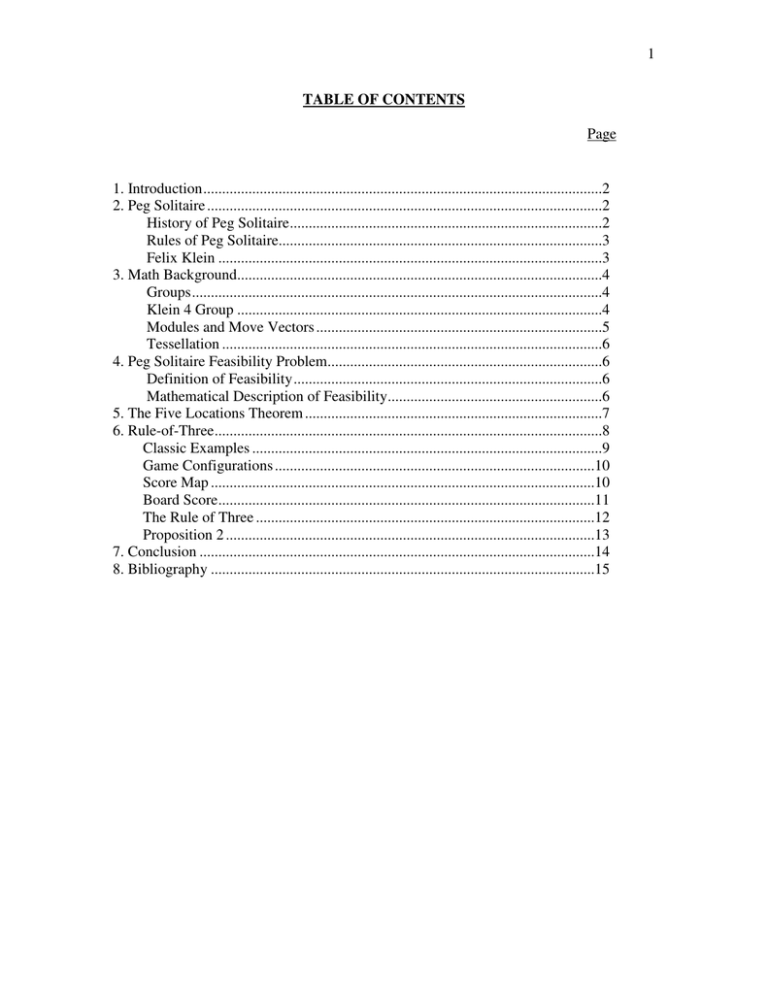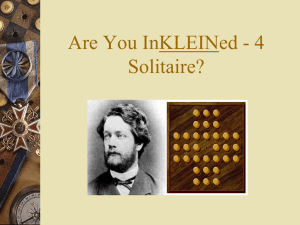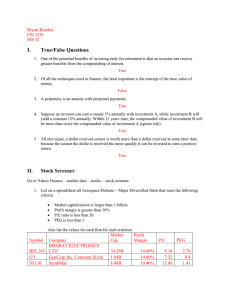Document 10888248
advertisement

1
TABLE OF CONTENTS
Page
1. Introduction..........................................................................................................2
2. Peg Solitaire .........................................................................................................2
History of Peg Solitaire...................................................................................2
Rules of Peg Solitaire......................................................................................3
Felix Klein ......................................................................................................3
3. Math Background.................................................................................................4
Groups.............................................................................................................4
Klein 4 Group .................................................................................................4
Modules and Move Vectors ............................................................................5
Tessellation .....................................................................................................6
4. Peg Solitaire Feasibility Problem.........................................................................6
Definition of Feasibility..................................................................................6
Mathematical Description of Feasibility.........................................................6
5. The Five Locations Theorem ...............................................................................7
6. Rule-of-Three.......................................................................................................8
Classic Examples .............................................................................................9
Game Configurations .....................................................................................10
Score Map ......................................................................................................10
Board Score....................................................................................................11
The Rule of Three ..........................................................................................12
Proposition 2 ..................................................................................................13
7. Conclusion .........................................................................................................14
8. Bibliography ......................................................................................................15
2
Introduction
Welcome to our Math Models presentation. In the next half hour, we will be
discussing the use of Modern Algebra, specifically the Klein-4 Group, to find possible
solutions and algebraic applications to the English version of Central Peg Solitaire.
Peg Solitaire
History of Peg Solitaire
French noblemen invented the game of peg solitaire in the 17th century, while they were
imprisoned in the Bastille. In 1710, the famous German mathematician, Leibnitz wrote
about the game. Peg solitaire used the Fox & Geese Board that was used in many board
games prior to the 14th century. The game is played by two people and consists of a black
token (the fox) and 13 white tokens (the geese). A picture of the game is shown below.
The goal of the player with the black token is to jump over as many white tokens
in order to prevent his own capture. The goal of the player with the white tokens is to
maneuver his pieces in such a way as to prevent the movement of the black token.
The following pictures below are some examples of the game. Take a look at the
French Solitaire example. Note the four extra peg holes in the corners. However, the
same rules apply to this game.
3
Teasing Pegs
HI-Q
Jewish Version
(French Solitaire)
Rules of Peg Solitaire
1. A peg can only move in the following directions: North, South, East, and
West. A peg cannot be moved along a diagonal.
2. A peg can only move by jumping over another peg to an empty peg hole.
3. To win, the pegs should be moved in such a way as to have one remain on
the board.
Felix Klein
Felix Klein
Our project will model peg solitaire on the Klein-4 group, named after Felix
Klein. He is famous for his work in Non-Euclidean geometry, connections between
geometry and graph theory, and function theory. He was born on April 25, 1849, in
Dusseldorf, and died on June 22, 1925. After attending the gymnasium at his hometown,
4
he studied mathematics and physics from 1865-1866 at the University of Bonn with the
intention of being a physicist. All that changed when he became the assistant to Plucker.
When he got his doctorate in 1868, he was given the task of finishing the work of the late
Plucker. In 1972, he became a professor at Erlangen in southern Germany. He also held
a chair there at the young age of 23. Three years later, He accepted a job at the
Technische Hochschule at Munich. While there, he taught many future mathematicians
like Runge and Planck. From 1880 to 1886, he was appointed a chair of geometry at
Leipzig. Sadly, his life took a turn for the worse. During that time, his health
deteriorated and he suffered from depression. This spelled the end of his career as a
research mathematician. Finally, in 1886, he accepted another chair position at Gottingen
where he taught courses with connections between mathematics and physics until he
retired in 1913.
Math background
Groups
First we will define the algebraic concept of Groups. To form a Group a few
assumptions must be made. We will assume G is a nonempty set with an operation *.
We will also assume that “a”, “b”, “c” are elements of G, and that “e” is the identity
element of G. G will then form a group if the following conditions hold:
1. Binary Operation
2. Associative
a*b∈G for all a, b∈G
(a*b)*c = a*(b*c) for all a, b, c∈G
3. Identity
a*e = e*a =a for all a∈G
4. Inverses
a*b = b*a = e
There are also some special properties that a group may have. A group is Abelian if
a*b= b*a for any a,b∈G. A group is Cyclic if there exists an element a∈G such that
G = { a n | n∈Z}. In this case all the elements of G are powers of a and a is called the
generator of G.
Klein 4 Group
Felix Klein developed the Klein 4 Group, which is a finite group containing three
nonzero elements, and the identity which is zero. It is an additive group and has two
5
special properties. First, every element is its own inverse. This can be proven from the
table below. When you add X+X the answer is 0. Zero is the identity element, therefore
X is it’s own inverse. The second property says that the sum of two distinct nonzero
elements is equal to the third nonzero element. Again from the table you can clearly see
that X+Y=Z. In addition to these properties it can be shown that the Klein 4 Group is
Abelian, and the direct sum of two additive Cyclic groups.
Modules and Move Vectors
An Integer Module is similar to a vector space, and will be used to represent
vectors on the Peg Solitaire board. In our case the Integer Module contains both
Configuration Vectors, and Move Vectors. Contained in these vectors are values for
lattice points. Think of the board as a grid. Each hole in the board has a specific value.
These values are what make up the Integer Modules.
Move Vectors are represented by the four equations below. There are four moves
that can be made. A peg can be moved up, down, left, or right. A move is made by
adding a peg to the first configuration vector, and subtracting the two other configuration
vectors.
r i , j =ei +1, j −ei , j −e i −1, j
l i , j =ei −1, j −e i , j −e i +1, j
d i , j =e i , j −1 −ei , j −ei , j +1
u i , j =ei , j +1 −ei , j −e i , j −1
There are two Module Homomorphism properties that will be used later in the
Five Locations Theorem and the Rule of Three. The first property is addition and is
6
represented as φ (a + b) = φ (a) + φ (b). The second property is scalar multiplication
and is represented as φ (ca) = c φ (a). Along with these properties, we will also use the
definition of a Kernel in the proofs. A Kernel of a homomorphism φ from a group G to
another group is the set: { X ∈ G | φ ( X ) = e }. The Kernel of φ maps every element in G
to the identity element of the other group and is denoted as Ker φ
Tessellation
A Tessellation is a mapping of the Klein 4 Group elements onto the Peg Solitaire
Board. The elements are placed in the peg holes of the board. This will be important in
determining the game configurations and wining combinations later in the paper.
.
Peg Solitaire Feasibility Problem
Definition of Feasibility
Now we can set up the Peg Solitaire Feasibility Problem. Something is “feasible”
if it can be done easily, and is likely. We have three objectives for the feasibility
problem. First we want to prove whether a certain board configuration is possible.
Second, we must prove there is a legal sequence that transforms one configuration into
another. We will use the Five Locations Theorem and the Rule of Three to solve the Peg
Solitaire Feasibility Problem.
Mathematical Description of Feasibility
The feasibility problem can be set up in the following way. We are given a board
B and a pair of configurations (c, c′) on B. To solve the problem we need to determine if
the pair is feasible. The solitaire board is defined as follows:
B ⊂ Z 2 = ZxZ
The board is a set of integer points in a plane. c and c′ are tessellations or configuration
vectors on the board. c′ is equal to 1 – c and is the opposite of c.
The Five Locations Theorem
7
Dr. Arie Bialostocki of the University of Tel-Aviv in Israel concluded that if a
single peg is to remain in a game of central peg solitaire, the peg must exist in one of five
locations. The initial board configuration (a) and the possible single peg game ending
situations (b) are as follows:
→
In order to prove this we need to first revisit the two properties of Klein 4 Groups.
They are as follows:
I.
Every element is it’s own inverse.
II.
The sum of any tow distinct non-zero
elements is equal to the third non-zero
element.
Therefore, the sum of the three non-zero elements = 0. Now we must tessellate
the board with x, y, and z elements from the Klein 4-Group. In doing so, we have a
board with the following tessellation (a):
We begin in row one, column one and map the
elements to a 7x7 board from left to right and top to
bottom while ignoring the fact that the board is not
actually a 7x7 square.
Next, using the properties of addition for Klein 4-groups, we add up all of the
locations that initially have a peg at the beginning of the game. In doing so, the x + y + z
8
values cancel each other out until we are left with only y. Therefore the initial value of
the board (a) is equal to y. Also, when making a jump, the value of the two pegs that are
being used to initiate the jump (c) are going to always be equal to the value of the peg
remaining after the jump by property II of Klein-4 Groups.
Hence, the board will always have a value of y regardless of what moves are
made. Then looking at our board tessellation (a) there exist only eleven locations in
which a peg could be left as there are eleven y locations on the board. However,
applying the horizontal and vertical rules of symmetry, we loose six of these eleven
locations. This leaves us with five y locations that could be achieved (b).
Therefore, using the Klein 4-Group of Modern Algebra, we can see that Dr.
Bialostocki’s “Five Locations Theorem” holds.
Rule-of-Three
In order to properly analyze the game of peg solitaire we need to define a notion
of scoring.
Let
Ζ :=
2
{a, b, c, e}
9
Ζ
2
is defined as a Klein 4 – Group. It is an Abelian group with identity e and the
following properties
a+a=b+b= c+c=e
a + b = c, a + c = b , b + c = a
Ζ
2
2
is the Klein Product Module. It is a set of ordered pairs of Klein group objects. An
example would be the following { (a,b), (b,b), (c,b), (a,c)……}etc.
Classic Examples
The following are some classic examples of scoring the game. Define two
maps g
1
,
g
2
:
Ζ
2
→
Ζ
2
2
g1
g2
As you can see, each coloring consists of multiple locations of a, b, c. The following
tessellation functions show how they were able to define these mappings. The assigned
value of a, b, or c depend on the initial location which is denoted by ( i , j ).
g (i, j ) := a
1
if (i + j ) ≡ 0 (mod 3)
g
2
(i, j ) := a if (i − j ) ≡ 0 (mod 3)
b if (i + j ) ≡ 1 (mod 3)
b if (i − j ) ≡ 1 (mod 3)
c if (i + j ) ≡ 2 (mod 3)
c if (i − j ) ≡ 2 (mod 3)
10
Game Configurations
A single peg or “basis vector” is represented by the following notation:
e
= (0,0,......0,1,.....0)
ij
Each 1 denotes that the hole is filled with a peg. Each 0 denotes that the hole is empty.
Score Map
This will lead us into the definition of a score map. It is a module homomorphism or a
linear like map.
For any board B ⊂
φ:
Ζ
Ζ
2
, the score map can be defined by
→
B
Ζ
2
2
ZB represents all of the possible move configurations.
As shown by the previous example, we can find the score map of a basis vector by
φ (eij )
→ ( g (i, j ),
1
g
2
Thus the score of the configuration c ∈
c
φ(c) =
( i , j )∈B
ij
(( g (i, j ),
1
g
(i, j ))
Ζ
2
B
is equal to the following notation
(i, j ))
The following would be an example of a score map.
in (0,0) and is empty everywhere else.
Proof:
φ( e0, 0 ) = 1* (
g (0,0)
1
= 1 * (a , a)
= (a , a)
, (
g
2
(0,0))
e
0,0
is a board vector that has a peg
11
= (a , a)
The c is replaced with a value of 1 because the hole is filled with a peg. (a, a) is found by
looking at the classic examples that were stated before. The leaves us with the ending
value of (a,a)
Board Score
This leads us into determing what the value of the board score would be.
Let B = English 33- board
Proof:
φ (B)= φ( e0, 0 ) + φ (1 -
e
0,0
)
= (a , a) + (a , a)
=(a + a, a + a)
=(e , e)
Another aspect that we have to take into consideration is
m
ij
∈
Ζ. m
B
ij
represents
all of the possible move vectors. We can show that φ (mij ) = ( e, e) through the
following proof:
For example,
12
r
ij
=
e
−
i +1, j
e
e
−
ij
i −1, j
φ (r 0, 0) = φ (e1,0) − φ (e0, 0) − φ (e−1,0)
φ (r 0, 0) = (b, b) − (a, a) − (c, c)
φ ( r 0 , 0 ) = (c, c ) − (c, c )
φ (r 0, 0) = (e, e)
r
ij
represents the right move vector that was explained earlier in the paper. We can refer
back to the classic examples again to find the value of (b,b) for φ (e1, 0) , (a,a) for
φ (e0, 0) , and (c,c) for φ (e−1, 0 ). Because of the properties of groups, subtraction is
considered the inverse of addition. After some simplification, this leaves us with the
value of (e,e).
The Rule of Three
A necessary condition for a pair of configuration (c, c′) to be feasible is that φ (c′ - c) =
(e, e), namely, c′ - c ∈ Κer(φ).
Proof:
−
Suppose (c, c ) is feasible.
k
Then c′ = c +
φ (c′) = φ [c +
i =1
k
i =1
i
m
i
m]
i
φ (c′) = φ (c) +
φ( m )
φ (c′)= φ (c) +
(e,e)
φ (c′)= φ (c) + (e,e)
13
φ (c′) - φ (c) = (e,e)
a(c′ - c) = (e,e)
i
m
represents all of the possible move vectors. You can see that the following steps of
the proof are simplified through linearity.
Proposition 2
−
Let B be any board. A necessary condition fro the configurations pair (c, c ) to be
−
feasible, with c = ∏ - c the complement of c, is that the board score is φ(B) = (e,e).
Proof:
−
−
Assume(c, c ) is feasible. c = ∏ - c
−
By the Rule of Three c - c ∈ Ker(φ), i.e.
−
φ( c - c ) = (e,e)
−
φ( c) - φ( c ) = (e,e)
−
φ( c) = (e,e) + φ( c )
−
φ( c) = (e,e) + φ( c )
−
φ( c) = φ( c )
However:
−
φ(B) = φ( c) + φ( c )
φ(B) = φ( c) + φ( c)
φ(B) = (e,e)
You can again see that the following steps of the proof are simplified through linearity.
14
Conclusion
By using the Five Locations Theorem, and the Rule of Three, we have shown how
it is possible to come up with the winning combinations in peg solitaire, and have shown
why they work. The following are some possible questions that we would like to address
for next semester.
1. Can this model be applied to other games?
2. How many solutions are there to the Peg Solitaire Game?
3. Is there a general algorithm for solving central solitaire?
15
Bibliography
References:
1. Dr. Steve Deckelman
2. “An Application of Elementary Group Theory to Central Solitaire”
by Arie Bialostocki
3. “Solitaire Lattices”
by Antoine Deza, Shmuel Onn
Websites
4. http://bio.bio.rpi.edu/MS99/WhitneyW/advance/klein.ktm
5. http://libra ry.thinkquest.org/22584/temh3043.htm
6. http://physics.rug.ac.be/fysica/Geschiedenis/mathematicians/KleinF.html
7. http://www.ahs.uwaterloo.ca~museum/vexhibit/puzzles/solitaire/solitaire.html
8. http://library.thinkquest.org/22584/temh3043.htm
9. http://bio.bio.rpi.edu/MS99/WhitneyW/advance/klein.htm
10. http://physics.rug.ac.be/fysica/Geschiedenis/mathematicians/KleinF.html
11. http://www.ahs.uwaterloo.ca/~museum/vexhibit/puzzles/solitare/solitare.html






